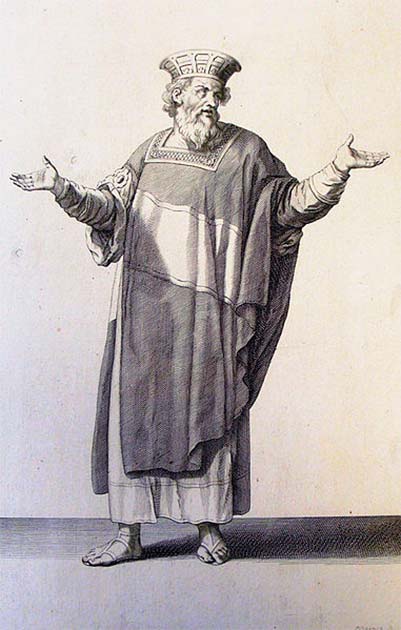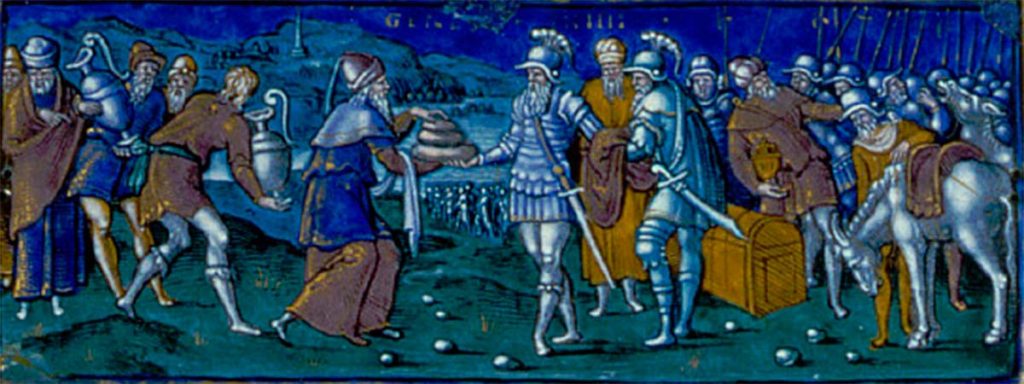Melchizedek is a figure in the Hebrew Bible (Old Testament) and a figure of importance, because he was both a priest and a king. He was connected with Jerusalem and revered by the original Biblical patriarch Abraham, who was said to have paid a tithe to him.
He appears as a person in Genesis when Abraham is rescuing his kidnapped nephew Lot. They fought and defeated a coalition of Mesopotamian kings under Chedorlaomer.
All this would make him just another Old Testament figure, but the story does not stop there. What is interesting is that in Christianity, according to the Epistle to the Hebrews in the New Testament, Jesus was identified as a “High Priest forever in the order of Melchizedek”.
It has been suggested that the story of Melchizedek is a late insertion into the Genesis narrative. It is perhaps that it was to give validation to the priesthood and the tithes and connected with the Second Temple, which was also known as Herod’s Temple.
Additionally, it has been suggested Zedek as a suffix would be used as a reference to the Canaanite deity which was worshipped in pre-Israelite Jerusalem. There is also a Ugaritic reference, older than the 12th century to a god named Saduq (righteousness) which may have been a corruption of Zedek.
A Mystery of the Hebrew Bible
The majority of the texts that have been found, especially those of Masoretic Hebrew origin, have the name written as two words, Malki-sedeq. In the King James Bible from 1611 the name is combined however and becomes Melchizedek.

It is made up of two elements. “Melek” which can be translated as king whilst “sedeq” can be translated as righteousness. This means that the name translates directly to the king of righteousness.
- Apollonius of Tyana Similarities to Jesus Christ
- Swoon or Substitute? Two Rationalizations of the Resurrection of Jesus
In Genesis 14, the story of how Abraham returned after defeating King Chedorlaomer, and he met with the King of Sodom, Bera. It was at this point that Melchizedek, as king of Salem, brought out bread and wine. At this point, Melchizedek was the priest of God and he blessed Abraham.
It has been argued by textual critics that the passage above was not written in the usual Pentateuchal format or from the correct sources. It has been suggested that the verses 18-20 in which Melchizedek appears are an informal insertion into the narration and that it disrupts the meeting of Abraham and Bera.
There has yet to be a consensus on why or when the story may have been inserted. This is why it is speculated that it was inserted in order to give validity to the priesthood, their tithes, and the Second Temple. However, it may also have been inserted in order to give Zadokite priests superiority over the Levite priests.
The following passage has even left some ambiguity about who actually gave the tithe and who received it. It says:
“And Melchizedek king of Salem brought out bread and wine: and he was [is] the priest of the most high God. And he blessed him, and said, ‘Blessed be Abram to the most high God, possessor of heaven and earth, And blessed be the most high God, which hath delivered thine enemies into thy hand’. And he gave him tithe from all.”
Many of the modern translations of this text have kept the ambiguity in the passage. They translate it to “he gave to him”. However, some modern translations have explicitly claimed that Abraham was the giver of the tithe while Melchizedek received it.
This has come under some scrutiny because in verses 22-23, Abraham refuses to take any of the booty for himself and so it would be unusual for him to have already given away a tithe to somebody else. It also poses a problem in regard to a biblical figure recognizing the authority of a Canaanite priest-king which has no parallel in any other biblical literature.
Psalm 110
The other and final mention of Melchizedek in the Hebrew Bible is in Psalm 110. It follows the Septuagint, a translation of the Hebrew Bible recognized as the first one in antiquity. It says:
“The LORD hath sworn and will not repent: ‘Thou art a priest forever after the manner of Melchizedek.”
- Midwinter, and the Pagan Origins of Christmas
- Land of the Rising Sun: Did Jesus Retire To Rural Japan?
However, Psalm 110 is not only known for this. It is also the most quoted psalm in the New Testament as it pays careful attention to Christ’s execution of the offices of king and priest. King David is said to have written this psalm for a future king. It has been suggested that it was perhaps for Solomon’s ascension to the throne in 971 BC.

The Psalm begins by saying that a future king will be given more power and authority than any before him as he would sit at Yahweh’s (the god of the Israelites) right hand. This suggests that he derives power from Yahweh and exercises this power over the people.
But importantly, this figure is not only meant to be a king but a priest in the order of Melchizedek. This would give the kings of the David dynasty divine support over the promised land which harks back to the fulfillment of Abraham’s blessing from Melchizedek in Genesis. This is foundational for understanding how Jesus can occupy the dual offices of priest and king.
Following Melchizedek, it has been suggested that the next king of true righteousness is Jesus. This is because Jesus lived the perfect life that no human could. It is because of this that Christ is the true king of Salem and according to the gospels of the Hebrews, he is a priest forever after the order of Melchizedek.
Importantly, Jesus does not hold this through the Levitical lineage (Hebrew priests in biblical tradition come from the Jewish tribe of Levi) which would make his priesthood superior as it continues forever. It has thus been argued that Melchizedek is an antecedent to Jesus and sets up Jesus to be the perfect King to rule with power and justice.
As well as this, Jesus is the perfect Priest with infinite sympathy and mercy. Whilst it cannot be argued that Melchizedek is of the same stature as Jesus, it certainly seems that he was a precursor to Christ.
Top Image: The meeting of Abraham and Melchizedek, by Peter Paul Rubens. Source: Peter Paul Rubens / Public Domain.
By Kurt Readman